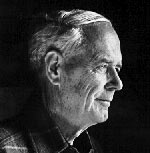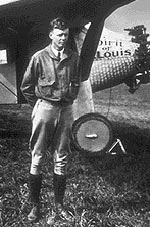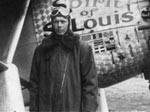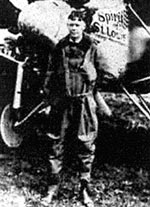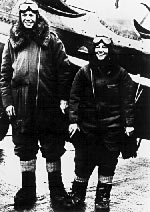
Charles Lindbergh and the Heart Pump
After Charles A. Lindbergh
had flown solo across the Atlantic, he had a ticker-tape parade through
New York. No
pun is intended on the word 'ticker', except that the hearts of people
in America and all around the world did go out to the brave young pilot
and his little plane.
People tend to know the story of that flight, and they also know about Lindbergh that his baby son was kidnapped and killed, and that a German by the name of Hauptmann was blamed for that terrible deed, even though many firmly state now that Hauptmann was framed by police eager for a conviction in so public a case. And talking about a German fairly soon leads people to talk about Lindbergh's Nazi sympathies which swiftly lost him the huge following he had so suddenly gained.
But there is also a story of an invention by Lindbergh, and it make something of a companion piece to the tale of Hedy Lamarr's patent, except of course that there is a more direct connection between Lindbergh and technology. He would have had to know something about machines in order to fly an aeroplane in those days. Indeed Lindbergh had made important contributions to the design of The Spirit of St. Louis as the aircraft was called. It certainly worked; it took him to France.
And within a few short years, 'Lindy' was back in France, in fact he was back in Lyons, where he had landed on the greatest day in his life.
Some years before a relative of Lindbergh's had suffered heart trouble. Doctors couldn't operate without stopping the heart, but that would have killed the patient . That struck Lindbergh as a solvable problem, and he hoped the time would come when he would be able to address it.
In 1935, after enduring a three-year ordeal involving the kidnapping and murder of their first born son and the trial of the man accused of committing the crime, Charles and Anne Morrow Lindbergh chose to flee the country that had made them national icons. Charles, whose battles with the media over issues of privacy were long-standing, confided to a friend that, "We Americans are a primitive people. ...Americans seem to have little respect for the law or the rights of others." The Lindberghs found sanctuary in the English countryside. But two years later, they moved again, this time to a tiny island off the northwest coast of France. One reason for their choice of locales was so Charles could work more closely with a certain Nobel prize-winning scientist.
Alexis Carrel had won world-wide acclaim for his work in organ transplants and suturing blood vessels. Carrel was highly respected, but he was odd. His operating room was solid black. So were the gowns that people had to wear in the operating theatre. Author Christopher Hallowell tells us that Carrel "flirted with arcane mysticism" and that he harbored bizzare racial theories. But then, so did Lindbergh. The two men liked each other immensely.
Carrel soon askied if an external blood pump could sustain a patient's body while an operation on the heart continued. Lindbergh studied the problem and quietly went back to the united States and to a Princeton University glass blower. Two weeks later he came back with his own blood pump. Carrel was delighted and invited Lindbergh to continue work in his laboratory. Lindbergh did. He produced a series of pumps that didn't quite work.
In 1935, he finally produced a working blood pump. He also produced a lot of the supporting technology. He'd made a centrifuge to separate blood plasma without damaging it. Carrel sang the praises of the work. Lindbergh was on the cover of a 1938 Time magazine with his invention. The press wrote about transplants and implants and the medical miracles right around the corner. Maybe the pump itself could be miniaturized and used to replace the human heart?
The terrible ordeal Lindbergh had been through with the kidnapping of his baby had happened three years before. Also, photographs of Lindbergh at the Berlin Olympics and receiving honours from the Nazis had made millions of people drop him as their hero.
Then World War II began, Lindbergh, the Nazi-sympathiser who had declared that Hitler would win the War, actually flew combat missions for the Allies in the Pacific. Most of the pumps Lindbergh and carel made were were broken up for the platinum in them.
Carrel died shortly after the war. he had been accused of working for the pro-Nazi Vichy Government. The cause of death was, of all things, a heart attack.
In the 1960's, Lindbergh found himself back in biomedical science -- at the Naval Medical Research Institute in Bethesda, Maryland, redesigning its organ perfusion system. The Navy had established a cryobiological-perfusion research program with the objective of 'creating a storage bank of human organs for transplantation', another idea dismissed as 'impossible' a generation earlier.
Lindbergh died in 1974 just as the world was being introduced to recombinant DNA technology. He missed the 'dawn of biotech.'
He also missed the boat, in the end. Lindbergh declared that science 'clarifies man's vision beyond his birth and death and links him to universality. Unfortunately the abiding and wide-spread vision of Charles A. Lindbergh is not that of a hero beside a plane, or a farsighted inventor, but a blind young man letting down humanity, his country and himself by wearing the insignia and decorations of the monstrous Nazi regime.
